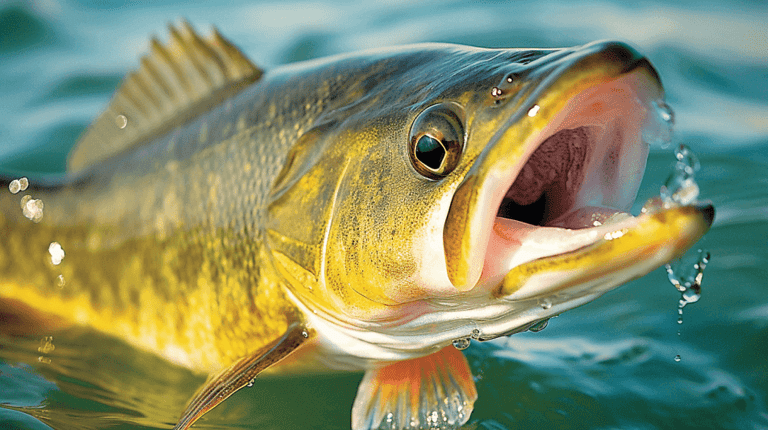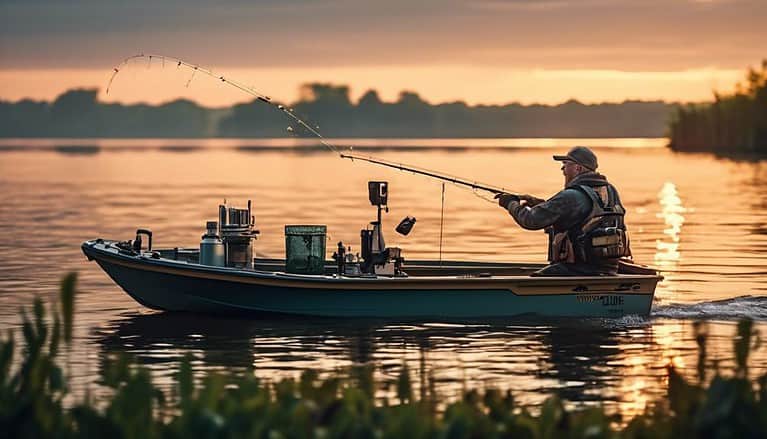5 Essential Tips: Choosing a Fishing Rod for Lake Erie – 2024

The Complete Guide to Choosing Your First Fishing Rod: Lake Erie Edition
Lake Erie, renowned for its diverse fishery, holds more secrets beneath its waves than you might expect—secrets that begin with the rod in your hands. As you stand on its shores, you’re not just holding a tool; you’re wielding a key to unlocking the lake’s rich angling potential. In this comprehensive guide, you’ll navigate through the intricate process of choosing your first fishing rod—one that’s not only compatible with the lake’s varied species but also feels right for you. You’ll learn that length, action, and material aren’t just specs; they’re critical factors that can make or break your experience on these waters. Let’s begin your journey to mastering the art of the perfect selection, so you can transform anticipation into achievement with every cast you make.
Table of Contents
Key Takeaways
- Consider the rod length based on your casting distance needs and control preferences. Longer rods allow for casting further and covering more water, while shorter rods offer superior control for quick and precise movements.
- Select the right rod material based on the fishing conditions and target fish species. Fiberglass rods are durable and flexible; graphite rods are lightweight and provide faster action; and composite rods offer a blend of both qualities for versatility.
- Understand the different rod actions available and choose one that suits your angling style and the fishing techniques you intend to use. Fast-action rods offer sensitivity and firm hook sets; medium-action rods provide versatility; and slow-action rods offer a gentle presentation.
- Determine the appropriate rod power based on the fish species you will be targeting. Matching the rod power with the target species enhances your ability to catch fish and ensures a thrilling yet manageable battle.
Understanding Rod Length Importance

When selecting your first fishing rod for Lake Erie adventures, it’s crucial to consider rod length, as it directly affects your casting distance and your control over a catch. Longer rods grant you the reach necessary to cast further, helping you cover more water and increasing your chances of encountering various fish species. On Lake Erie, where wide-open spaces are the norm, an extended casting range can be a game-changer.
However, it’s not just about the distance. The length of your rod also influences the leverage you wield when it’s time to reel in your prize. Longer rods provide more power to fight large fish, while shorter rods give you superior control for quick, precise movements. This is particularly important when you’re dealing with Lake Erie’s diverse inhabitants, from walleye to smallmouth bass.
You’ll also want to factor in the rod guides. Quality guides enhance your rod’s performance by minimizing friction and wear on your line. As you refine your technique, these components are vital in delivering a smooth cast and ensuring the longevity of your gear. So, choose a rod that balances length with quality features, tailored to the vast waters and varied fish of Lake Erie.
Selecting the Right Rod Material

As you venture into the world of Lake Erie fishing, selecting a rod with the right material is as crucial as understanding local conditions and fish behavior. When you’re browsing fishing rods, you’ll encounter different types of rod material, each with unique qualities to suit your angling style.
Fiberglass rods are a go-to for many beginners. They offer the durability and flexibility needed to tackle the diverse fish species in Lake Erie. Their forgiving nature makes them a solid choice if you’re after larger fish that demand a rod capable of absorbing vigorous fights.
For those of you who prize sensitivity and precision, graphite rods are your best bet. They’re lightweight and provide faster action, which means you’ll feel even the most subtle nibbles and have the upper hand in casting accuracy. The heightened sensitivity is a game-changer when you’re trying to outsmart Lake Erie’s elusive walleye or bass.
Composite rods are the all-rounders of the rod and reel world. They blend fiberglass’s robustness with graphite’s sensitivity, giving you a versatile tool that’s up for any challenge Lake Erie throws your way.
Deciphering Rod Action Choices

Understanding rod action is essential for refining your hook-setting technique and enhancing the sensitivity needed to detect those subtle Lake Erie bites. When you’re aiming to reel in an Erie walleye, the right rod action can make all the difference. It’s not just about the strength of your fishing rod; it’s how it bends and flexes under pressure.
Fast-action rods bend primarily near the tip, offering you the sensitivity to feel even the slightest nibble and the backbone to set the hook firmly. They’re ideal for jigging, which is a popular technique for Erie walleye. A medium-action rod, bending more towards the middle, offers versatility. It’s an all-rounder that lets you cast various lures and baits with precision, making it a great choice if you’re an angler who uses a variety of techniques.
Slow-action rods flex down into the butt section, providing a gentle presentation perfect for live bait but less ideal for hook setting. Your spinning rod choice should complement your angling style; finesse anglers lean towards fast-action, while those who prefer power fishing might opt for medium-action rods.
Determining Appropriate Rod Power

While considering rod action tailors your technique for Lake Erie’s subtle bites, selecting the right rod power ensures you have the strength to battle the lake’s diverse fish species. You need to match rod power with the fish you aim to catch; it’s the amount of pressure needed to flex your fishing rod. Different rods offer varying degrees of power, from ultra-light for the smallest panfish to heavy power for the trophy walleye or steelhead.
When you’re on Lake Erie, you’ll want a rod that gives you the upper hand. Here’s a table to help visualize the relationship between rod power, target species, and suggested line weight:
| Rod Power | Target Species / Suggested Line Weight |
|---|---|
| Ultra-Light | Small panfish / 2-6 lbs test line |
| Light | Perch, smaller walleye / 4-8 lbs test line |
| Medium | Walleye, small bass / 6-12 lbs test line |
| Medium-Heavy | Larger bass, steelhead / 8-14 lbs test line |
| Heavy | Trophy species, catfish / 14-20 lbs test line |
Choosing a rod power too light for Lake Erie’s conditions means you may not be able to handle the fight, while too heavy could reduce sensitivity. Find that sweet spot to enhance your ability to catch fish while ensuring a thrilling yet manageable battle.
Interpreting Rod Markings and Specifications

Deciphering the cryptic language of rod markings is crucial for matching your gear to Lake Erie’s fishing demands, as these codes reveal the rod’s length, action, recommended line, and lure weights. When you’re inspecting different rods, you’ll notice numbers and letters printed near the handle. These aren’t just random; they’re your key to unlocking the rod’s potential.
The length of a rod, usually given in feet and inches, determines your casting distance and accuracy. Rod action—fast, medium, or slow—indicates how much the rod bends when pressure is applied, which affects your hook setting power and sensitivity. You’ll want to align this with the types of fishing you’ll be doing in Lake Erie.
Look closely, and you’ll also find the recommended line weight. Match this with your fishing line to ensure your setup can handle the fight from walleye, bass, or perch. The lure weight specification guides you on the weight of the lures you can effectively cast.
Frequently Asked Questions
What Should My First Fishing Rod Be?
You’ll want a versatile rod that’s lightweight and sturdy, ideally a medium-power, fast-action spinning rod. It’s perfect for beginners and can handle a variety of fishing situations you’ll encounter.
What Size Fishing Rod Is Best for Beginners?
You’ll want a medium-sized rod, about 6-8 feet, as it’s versatile for various fishing situations and easier to handle. It offers a good balance of casting distance and accuracy for beginners.
How Do I Choose a Rod Guide?
You’ll want to pick rod guides that minimize line friction and evenly distribute stress. Look for ceramic coatings and proper sizing to ensure durability and enhance your casting precision for your fishing techniques.
How Many Rods per Person on Lake Erie?
You’re in luck—you can have two rods in the water per person on Lake Erie, but remember, Ohio’s rules only allow two lines, so count your casts carefully.
Conclusion
As the sun’s embrace recedes over Lake Erie, you’re now armed with knowledge, your chosen rod in hand—a true extension of your will. Feel its crafted balance and the promise of each cast as you dance with the waves and the elusive prey beneath. With every flick and tug, your rod speaks the language of the lake. Trust in its strength and finesse, for it is not just a tool but a companion on your journey to angling mastery.






